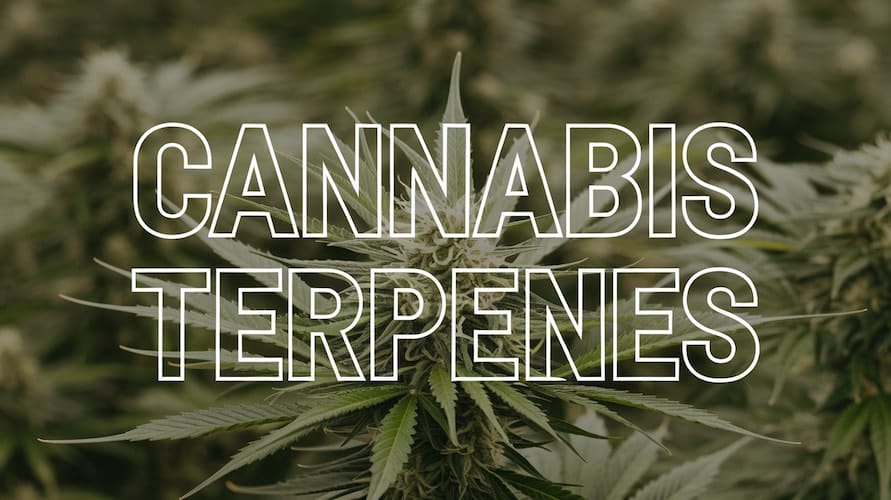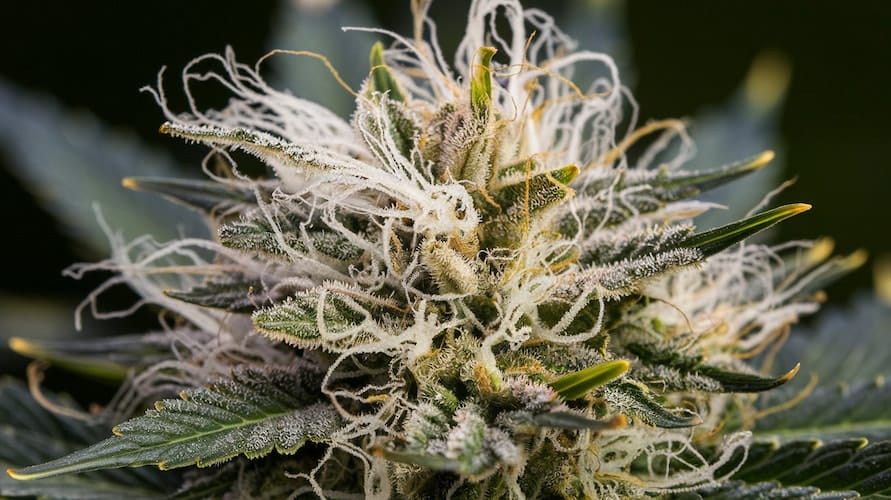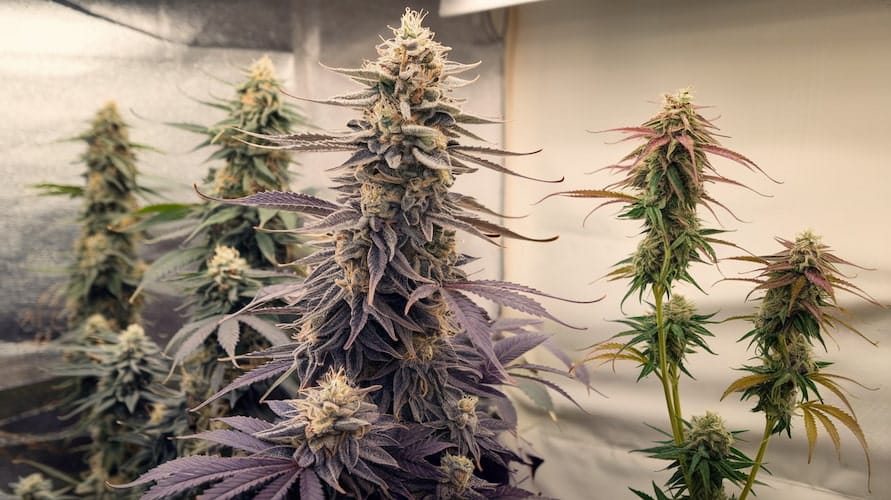Cannabis terpenes are fascinating hydrocarbon compounds that play a crucial role in the plant’s aroma and overall experience. Comprising monoterpenes, sesquiterpenes, and less commonly diterpenes, these molecules vary in structure and volatility. Monoterpenes, with two isoprene units, are highly volatile, giving each strain its unique scent, while the more stable sesquiterpenes contribute to long-lasting flavors.
Each cannabis strain boasts a distinct terpene profile, influencing both its psychoactive effects and medicinal benefits. Recent studies highlight terpenes’ potential in reducing inflammation, alleviating anxiety, and providing antidepressant effects. Found alongside cannabinoids like THC and CBD in the glandular trichomes, terpenes enhance the plant’s therapeutic properties, making them essential for understanding cannabis’s full potential.
What Are Cannabis Terpenes?
Terpenes are hydrocarbon compounds found in the Cannabis sativa plant, composed of isoprene molecules. They are classified into three main types based on their isoprene units:
- Monoterpenes: Consist of 2 isoprene molecules. Examples include limonene, β-myrcene, α-pinene, and linalool. These terpenes are highly volatile and primarily contribute to the plant’s aroma.
- Sesquiterpenes: Made up of 3 isoprene molecules. Examples are β-caryophyllene, caryophyllene oxide, Eβ-farnesene, and β-caryophyllene. They are more stable and provide longer-lasting flavors.
- Diterpenes: Comprise 4 isoprene molecules and are less common in cannabis.
Cannabis contains over fifty terpenes, with eight forming the Terpene Super Class:
| Terpene | Type | Number of Isoprene Units | Role in Cannabis
|
|---|---|---|---|
| Myrcene | Monoterpene | 2 | Enhances aroma, medicinal |
| Terpinolene | Monoterpene | 2 | Contributes to scent |
| Ocimene | Monoterpene | 2 | Adds floral notes |
| Limonene | Monoterpene | 2 | Provides citrus aroma |
| Pinene | Monoterpene | 2 | Adds pine scent |
| Humulene | Sesquiterpene | 3 | Offers earthy flavors |
| Linalool | Monoterpene | 2 | Delivers floral aroma |
| β-Caryophyllene | Sesquiterpene | 3 | Contributes spicy notes |
These terpenes reside in the glandular trichomes of the female cannabis plant’s inflorescences. Each strain’s unique terpene profile influences its distinct aroma, flavor, and potential therapeutic effects. Additionally, terpenes interact with cannabinoids like THC and CBD, potentially enhancing their medicinal properties through the entourage effect.
Recent studies highlight terpenes’ medicinal potential, including anti-inflammatory, anxiolytic, and antidepressant effects. For instance, β-caryophyllene interacts with the endocannabinoid system, offering anxiety-reducing benefits. Monoterpenes like limonene may uplift mood, while myrcene is associated with muscle relaxation.
Understanding cannabis terpenes provides insight into the plant’s complex chemistry and its varied applications in therapeutic and recreational contexts.
Common Cannabis Terpenes
Cannabis contains a diverse range of terpenes that shape its unique aroma and effects. Understanding these terpenes can enhance your appreciation of different strains.
Primary Terpenes
Primary terpenes are the most abundant in cannabis, significantly influencing its scent and therapeutic properties. Key primary terpenes include:
- Limonene: Offers a citrusy aroma and may provide mood-enhancing effects. It’s commonly found in strains like Super Lemon Haze.
- β-Myrcene: Known for its earthy scent, β-myrcene may promote relaxation and sedation. It’s prevalent in strains such as Blue Dream.
- α-Pinene: Provides a pine aroma and could support alertness and memory retention. Strains like Jack Herer are rich in α-pinene.
- Linalool: Exhibits a floral scent and might offer calming and anti-anxiety benefits. Lavender-inspired strains often contain linalool.
- α-Terpinolene: Adds a herbal aroma and may have antioxidant properties. It’s present in strains like White Widow.
- Tranocimene: Contributes a sweet, woody scent and is found in various hybrid strains.
Secondary Terpenes
Secondary terpenes are present in smaller quantities but still impact the overall terpene profile and effects of cannabis. Notable secondary terpenes include:
- β-Caryophyllene: Exhibits a spicy aroma and interacts with the endocannabinoid system, potentially reducing inflammation. It’s found in strains like Girl Scout Cookies.
- Caryophyllene Oxide: Offers a woody scent and may possess antimicrobial properties. It’s present in minor amounts in some indica strains.
- E-β-Farnesene: Provides a mild, sweet aroma and could have anti-anxiety effects. It’s found in select sativa strains.
- Ecaryophyllene: Similar to β-caryophyllene, it contributes to the spicy profile and may support pain relief. Found in strains like OG Kush.
These terpenes work together to create the distinct flavors, aromas, and therapeutic benefits associated with each cannabis strain.
Biosynthesis of Terpenes in Cannabis
Terpenes synthesize through the assembly of isoprene units within the cannabis plant. Monoterpenes form from two isoprene molecules, sesquiterpenes from three, and diterpenes from four. This classification determines their structural complexity and functional roles.
In Cannabis sativa, terpenes originate in glandular trichomes located on the female plant’s inflorescences. These trichomes also produce cannabinoids like THC and CBD, facilitating the interplay between terpenes and cannabinoids. The biosynthesis pathway involves the conversion of diterpene structures into phenol terpenoids, which constitute approximately 25% of the plant’s metabolites.
Cannabis Terpene Types and Abundance
The cannabis plant harbors over fifty terpenes, with eight primary terpenes predominating in North American strains:
| Terpene | Isoprene Units | Abundance
|
|---|---|---|
| Myrcene | 2 | High |
| Limonene | 2 | High |
| β-Myrcene | 2 | High |
| α-Pinene | 2 | High |
| Linalool | 2 | High |
| α-Terpinolene | 2 | Trace |
| Tranocimene | 2 | Trace |
| β-Caryophyllene | 3 | Predominant |
Monoterpenes like limonene and β-myrcene contribute significantly to the plant’s aroma due to their high volatility. Sesquiterpenes, including β-caryophyllene and caryophyllene oxide, offer more stability and persist through plant processing.
Biosynthetic Pathways
The biosynthesis of terpenes involves enzymatic reactions that convert precursor molecules into specific terpene structures. Terpene synthases play a crucial role in this process, determining the final terpene profile of each cannabis strain. Genetic variations among cannabis genotypes lead to diverse terpene compositions, influencing both aromatic and therapeutic properties.
Interaction With Cannabinoids
Diterpene-derived cannabinoids like THC and CBD interact with terpenes to enhance the plant’s effects through the entourage effect. This synergy between cannabinoids and terpenes amplifies their medicinal benefits, such as anti-inflammatory and anxiolytic properties. Understanding the biosynthesis of terpenes provides insight into optimizing cannabis strains for specific therapeutic applications.
Effects and Benefits of Cannabis Terpenes
Cannabis terpenes significantly influence the plant’s effects and therapeutic benefits. They interact with cannabinoids to enhance the overall user experience.
Therapeutic Uses
Terpenes offer various therapeutic applications by working synergistically with cannabinoids:
- Antianxiety: Linalool, found in lavender, provides antianxiety effects, promoting relaxation.
- Mental Alertness: α-Pinene, present in rosemary, invigorates the mind and enhances focus.
- Stress Relief: Myrcene induces calming effects, reducing stress levels.
- Pain Management: β-Caryophyllene targets inflammation and alleviates pain when combined with THC.
- Sleep Aid: Terpenes like linalool and myrcene support restful sleep by calming the nervous system.
Research indicates that terpenes amplify the therapeutic benefits of cannabinoids through the entourage effect, maximizing their efficacy in products such as CBD oils and edibles. This synergy fosters enhanced stress relief, energy boosts, and improved focus, catering to diverse health needs.
Extraction and Isolation of Cannabis Terpenes
I utilize various extraction methods to isolate terpenes from cannabis, ensuring high purity and preservation of their aromatic and therapeutic properties. Among the available techniques, Supercritical Fluid Extraction (SFE) stands out due to its superior performance in terpene recovery.
Supercritical Fluid Extraction (SFE)
SFE employs carbon dioxide (CO₂) at temperatures and pressures above its critical points, eliminating the boundary between liquid and gas phases. This method offers several advantages:
- Low Viscosity and High Diffusion: CO₂ efficiently dissolves chemical molecules from the plant matrix.
- Temperature Control: Lower extraction temperatures minimize the deterioration of thermally labile terpenes.
- Solvent-Free Process: Eliminates organic solvent contaminants, ensuring high product purity.
Terpene Yields Using SFE:
| Terpene | Yield Compared to Conventional Methods
|
|---|---|
| Caryophyllene | Up to 50% |
| Humulene | Up to 20% |
| Limonene | Up to 10% |
Solvent-Based and Solventless Extraction
Solvent-based methods, such as butane extraction, dissolve terpenes using organic solvents. However, these methods often leave solvent residues, affecting product purity. Conversely, solventless techniques like hydrodistillation and steam distillation avoid solvent contaminants but may result in the loss of some terpenes due to high temperatures.
Microwave-Assisted Extraction (MAE)
MAE enhances terpene extraction by using high irradiation power and extended extraction times. This technique significantly increases the content of bioactive compounds, including CBD, and achieves higher yields compared to conventional hydrodistillation.
Post-Harvest Terpene Preservation
Terpenes are highly volatile and degrade quickly at moderate temperatures. To preserve their integrity, I implement the following practices:
- Morning Harvesting: Collecting plants in the morning captures terpenes at their peak fragrance.
- Flash Freezing: Rapidly freezing crops preserves terpene levels, maintaining flavor and aroma.
- Controlled Environment: Managing temperature and humidity during storage prevents terpene loss.
| Extraction Method | Advantages | Disadvantages
|
|---|---|---|
| Supercritical Fluid (SFE) | High purity, solvent-free, preserves terpenes | Requires specialized equipment |
| Butane Extraction | Efficient terpene extraction | Potential solvent residues |
| Hydrodistillation | Solventless, maintains most terpenes | May lose some monoterpenes due to heat |
| Steam Distillation | Solventless, simple process | Limited terpene recovery compared to SFE |
| Microwave-Assisted Extraction (MAE) | High yield, increased CBD content | Energy-intensive, may require optimization |
By selecting the appropriate extraction method, I ensure the isolation of high-quality terpenes that retain their desirable characteristics, enhancing the overall quality and efficacy of cannabis products.
Terpenes and Cannabis Varieties
I categorize cannabis varieties based on their terpene profiles, which determine each strain’s unique aroma, flavor, and effects. Research identifies five chemotype groups according to predominant terpenes:
| Chemotype Group | Predominant Terpenes
|
|---|---|
| I | β-Myrcene |
| II | α-Pinene, β-Pinene |
| III | β-Caryophyllene, Limonene |
| IV | β-Caryophyllene |
| V | Terpinolene |
Additionally, cannabis strains fall into two sensory perception clusters:
- Earthy, Woody, Herbal: Common in Chemotype I and IV, these strains offer calming and grounding effects.
- Citrus, Lemon, Sweet, Pungent: Associated with Chemotype III and V, these strains provide uplifting and energizing experiences.
Each chemotype group imparts distinct therapeutic properties. For example, β-myrcene-rich strains enhance stress relief, while limonene-dominant varieties support mood elevation.
Understanding these terpene profiles enables selecting cannabis strains tailored to specific therapeutic needs.
Cannabis Terpenes: Final Thoughts
Exploring cannabis terpenes has deepened my appreciation for their role beyond just aroma. Understanding their unique profiles and interactions with cannabinoids has shown how they enhance both therapeutic and recreational experiences. It’s fascinating to see how these compounds contribute to the diverse effects of each strain. As research continues to uncover more about terpenes I’m excited about the potential they hold in optimizing cannabis for various needs. Embracing this knowledge allows users to make more informed choices and fully benefit from what cannabis has to offer.





